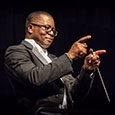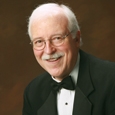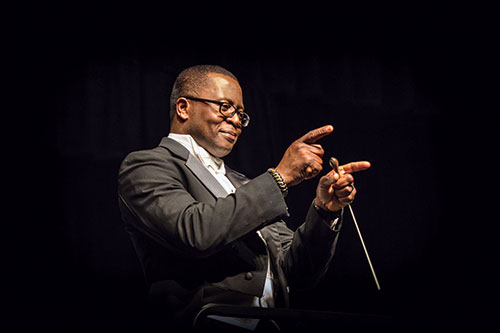
James Seda has been Director of Bands at Southwest DeKalb High School near Atlanta since 2001 and began his teaching career at Chapel Hill Middle School in the same district in 1999. He emphasizes that recruiting for a program is an ongoing task that begins long before students reach high school. “One thing that impresses the parents early is when you come up and say their student’s name. That shows a connection, and parents start to develop a trust. We maintain those relationships as students go through the middle school, and ultimately when they reach high school, they’re not new.” Seda earned a Bachelors of Science Degree in Music Education from Florida A&M University and pursued further studies at Northern Illinois University. His trumpet playing has taken him to Switzerland, Holland, St. Thomas, Jamaica, and across the United States. Among other media projects, he worked on the movie Drumline as a music arranger, creative consultant, instrumentalist, and acting extra.
When did you know that you wanted to teach music?
I knew in college. During my first two years at Florida A&M, I was an engineering major but spent so much time around music that I knew this was the direction for me. I dropped the engineering as a major and switched to music education. At the time I wasn’t sure about teaching; I just loved to perform. I had the opportunity to travel and play internationally. I completed my student teaching at the same high school where I teach now. The directors at the time attended Florida A&M years before I did. They threw me into the fire immediately. After a quick introduction, I was teaching an intermediate class by the third day. It was a wonderful experience as I had the opportunity to work and learn hard. I made a strong connection with students and discovered how much I loved teaching. I also figured out what I did not know.
What is the most rewarding aspect of your position?
I think it is making personal connections with students. When you get an opportunity to connect with a student and find out about their life, you realize that an organization like band is much bigger than music. It is a safe haven, a place where they can develop friendships and even set themselves up for a future career. I frequently remind students that they are part of a team and every member of the group has value from the most accomplished to the least experienced. Marching band helps to develop that feeling of community because you have all different ability levels working for a common goal.
I also tell students that everyone has a story. When an alumnus returns to visit us, I will stop rehearsal and introduce them. I will describe what they did in school and also what they are doing as adults. I try to recall an interesting fact or memory about the alum, perhaps a great performance or experience. It is another way to remind each student how we all contribute to the whole.
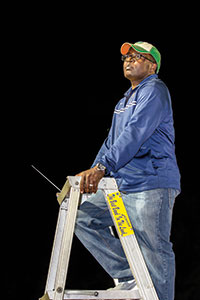 What strategies do you use to recruit students and keep them in your program?
What strategies do you use to recruit students and keep them in your program?
We are visible in the community and advertise our successes in every possible way. We connect with students from a young age so they know what to look forward to in high school. We have always had a good relationship with our elementary and middle school feeders to the point that we know students by name, and they know us from a young age. Fifth and sixth graders coming up through our cluster know each other. Our high school student leaders mentor, coach, and develop good relationships with the elementary and middle school students, occasionally offering musical and academic tutoring. We attend their performances; they attend our performances. Friendships are formed.
Each fall, we host a band day that allows the elementary and middle school students to spend the day with the high school band. Before one of our football games, we set up a festival like atmosphere with games, activities, and a big cookout. Even the parents get an opportunity to visit and develop relationships before we all get on the bus together to perform at the football game. Playing alongside the high school students leaves a tremendous impression on the elementary kids. We give each participant a band day t-shirt, and the kids tend to wear that shirt with great excitement because they feel such pride. It’s incredible. There are so many high school activities that compete for student time. I also discovered that many activities and clubs try to recruit band students because they have strong discipline and commitment. They know these students have a high sense of accountability. We do not try to compete with other groups for students, but we work hard to keep the band program interesting all throughout high school.
How do you balance your family life with the many demands placed upon your professional life?
I am blessed to have an incredible wife, Jennifer, who is a successful middle school band director. We were married two years ago. It is sometimes hard to find a balance because our programs each have about 200 students. When we are at home, we don’t talk band a lot, but we understand the demands and requirements of running a successful program. That common perspective helps us as we try to keep a balance at work and home.
What type of balance do you try to achieve between your marching and concert bands?
Marching band is a voluntary after-school activity that spans from band camp in late July to the last football game in November. In late April, we have a two-week mini camp intended to introduce middle schoolers to marching band, anticipating their rise to high school band. The culminating event is a spring exhibition performance. Everything else is concert band and ensemble work. Concert band is a year-round activity, and it drives the band program. We have three concert bands, a jazz ensemble, a percussion ensemble, and several instrumental chamber groups. Throughout the spring semester, marching band is inactive.
What types of warm-up strategies do you employ with your ensembles?
One benefit of a block schedule is seeing our students every day for 85 minutes. We begin the first 15 minutes of rehearsals with six minutes of long tones, six minutes of breathing exercises, and then various exercises. The brass play lip slurs, and the woodwinds might work on two-octave scales. We follow this written routine before we go into other music. It is easy to modify for advanced players or beginners.
What is your tuning process?
We start by tuning to a concert F. We play a concert F on the loud speakers and try to get everybody to center in on it. Then, I go from instrument to instrument starting with the low instruments and fine tune them. Tune their concert Bb pitch and play up to the note F, G, A, Bb. Four-valve brass instruments also tune low Cs. Trombones, euphoniums, trumpet all follow a similar process. Trombones with an F attachment and bass trombones will tune low Cs and Dbs. We tune three parts with the clarinets: the barrel, the middle joint, the low joint. Flutes will tune to Ab. Oboes will tune to An and Bb. Saxophones will tune to their F#. Horns must tune both sides of the instrument, playing C, Bb, Bn, and A, adjusting each valve slide. The process takes about ten minutes.
What are your daily goals for rehearsals?
I tell students that we want them to laugh every day. That is not a musical goal, but you can get so tense and focused close to a performance. Students are accepting of what happens in rehearsal and rarely complain. We want them to laugh every day.

How would you describe your rehearsal room management style?
My approach to managing rehearsals came from Alfred Watkins. In one of his sessions with directors, he said to monitor everything students do for the first two or three weeks in class. We meet them at the door, watch how they set up, and study to amount of time it takes to get in their seats. Class instructions are written on the board, and once in a while I put something in just to see if they are paying attention. By watching everything from entering the room to playing the first note, you avoid the temptation to hang out and talk with their friends. Outlining the lesson on the board lets kids know what is going to happen and in what order. This helps them focus on the expectations for the day. Once students learn the routine, they tend to follow it on their own.
Is there any secret to getting your ensemble to play so beautifully together as one?
It is no secret. I use an amplified metronome every day with each class and rehearsal. Throughout the breathing exercises, long tones, scale exercises, unison studies, and chorales, the clicks are sounding.This process teaches students to listen with great focus, subdivide rhythms, and play together with great accuracy.
Another method that helps my students is playing various exercises extremely slowly. We have a saying: “Slow practice is good practice.” On every day except Friday, exercises are very slow. Even if we’re playing a sixteenth note scaling exercises, I’ll dial the metronome down as low as it can go: quarter note=32. We set the subdivisions, so they’re playing these sixteenth notes but at a very slow pace.
The payoff to the students – because they all want to play high, fast, and loud – is Friday; we call it the fast day. Of course, fast is all relative. We play at quarter note=32 the first four days of the week, so quarter note=50 can be a fast tempo for them. When we dial the tempo up, and they can move their fingers successfully through the exercises, students still feel accomplished, but we still going at a snail’s pace tempo, to the point that they can feel each subdivision. The fast day gets faster as the year progresses, but for the slow days, the metronomic setting is always at 32.
I develop our literature much in the same way. After we do our initial read we take everything slowly, so the rhythms and subdivisions are as clear and clean as possible. Everyone understands where the pulses are before we move the tempos up. It really helps once we get up to the tempo on the page.
You told me earlier that one of your mentors encouraged you to develop a private lesson approach to teaching a full rehearsal. What does this mean to you?
My college band director, Julian E. White, often stressed the importance of developing a strong pedagogical knowledge of each instrument. Having long class periods allows us to have daily lessons and discussions about embouchure, breathing, tone production, intonation, hand position, tongue placement, and other essential methods. Our goal is to approach the study of these methods in the same manner as a student would receive in a private lesson.
In my community not many students can afford or have convenient access to private lessons. The daily lessons in class must be filled with good information on methodology and performance fundamentals. As a teacher, I continue my education by attending clinics, seeking the knowledge of my colleagues, and listening to good instrumental examples. I’ve discovered some cool new methods, but the proven old methods continue to work just fine.
How do you handle assessment?
We assess our students in three ways. The first is a weekly notebook check. It is important that students are neat and organized with music and material issued to them. Each student must also submit a weekly practice log, signed and dated by a parent. We trust that they will be honest with the practice hours that they report. Fridays are filled with playing tests. This includes scale exercises, tuning tests, solos and ensembles and excerpts of concert music.
Beyond being successful in their school curriculum, what advice would you offer university students as they prepare for a career in instrumental music education?
Try to find as many opportunities as you can to perform on your instrument. I am fortunate to play in the Cobb Wind Symphony, a community band that allows walk-ins. Having the chance to hear good sounds in a performance setting, gives perspective about what sounds to expect from your students. It is important to experience music simply as a performer, not just a teacher. Connecting with the joy of performing strengthens and encourages you as a young teacher in front of a group.
.jpg)
What are the most common mistakes that first-year teachers make?
First-year teachers often enter the profession without a clear plan for setting up a band program or steps to follow to accomplish their goals. Seeking the guidance of experienced, successful teachers to be mentors is vital to their development. Another common mistake that I have observed is how some young teachers would choose music for their ensemble or select activities that are only designed to make students happy but do nothing to enrich them artistically.
What, if any, roles have mentors played in your career?
The high school director when I was growing up, Curtis Byrdsong of Southside Comprehensive High School, was a mentor even before I joined the band. My older brother and sisters were all in high school band, and I loved to sit and watch my brother practice on euphonium or my sisters on saxophone and clarinet. They wouldn’t let me touch the instruments often, but they would always let me listen. I just admired the command and impression Mr. Byrdsong had on them, because they thought that he was the world. I always looked forward to the day that I could join band. My middle school teacher, James Camp, had the biggest impact on me. In the three years that I played in middle school band I gained such a high appreciation and love for music and playing the trumpet. He was a tough teacher, old school in every sense of the word. He had strict standards. He didn’t accept anything besides your best. We learned that early. He also was nurturing and compassionate, taking the time to learn every student’s situation. This school was in the inner city of Atlanta, and the majority of the band students lived in housing projects and government homes. We did not have much, and this gentleman managed to give us a successful band program in a community where you would not expect that. At Florida A&M, William Foster and Julian White convinced me that I could have a career in music. Their impact on me as accomplished music educators and musicians gave me and so many others the confidence to have success.
During my 18 years of teaching, a tremendous amount of guidance and mentoring has come from Don P. Roberts (DeKalb County School System Music Coordinator), Reginald McDonald (Tennessee State University Director of Bands and Orchestra), Natalie Brown (Director of Bands at Chapel Hill Middle School) and Alfred Watkins (Director of Bands, retired, Lassiter High School). Along with Julian E. White, they all continue to be guiding forces in my professional life.
What have been the keys to your success at Southwest DeKalb High School?
I started my career here and have never been anywhere else. Expectations are expectations regardless of where you are. As the county defines it, our school is about 98% African-American, 1% Caucasian, and 1% others. About 58% of our students receive free and reduced lunch. I find that students want discipline and structure. Students want to be in a safe place where they are nurtured and encouraged. They work hard to comply with whatever the standards and expectations are. They want to be part of something meaningful and work hard to stay.
I am exceptionally proud of our students and how they commit themselves to the program and artistic excellence. They want to be good. A high standard in this community might be completely different than a high standard in another community. We get them to listen to good music whether it is live or through social media or internet access.
I have experienced a few situations when after a successful band performance, people have asked about our groups, “how do they do that?” It is a loaded comment. They mean, “how do they do that where they come from?” We present our students with good information and expose them to the best music. They work hard and believe they can achieve excellence. I have always been proud of how the students step up.
One thing that impresses me most about my students is that when someone plays well in class, they clap. We do not rehearse this. They get to a point where they appreciate excellence. Everyone wants to feel that praise.
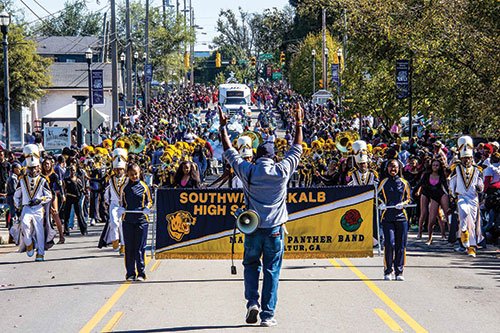
photos by Vincent Myers
